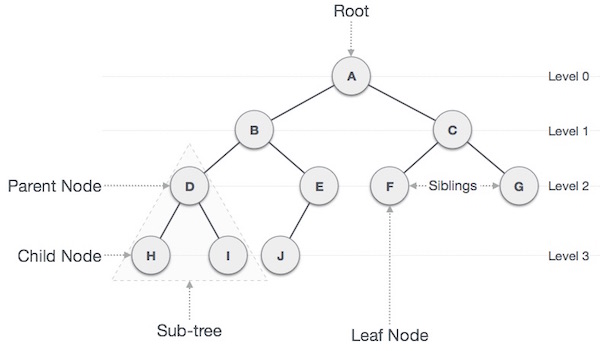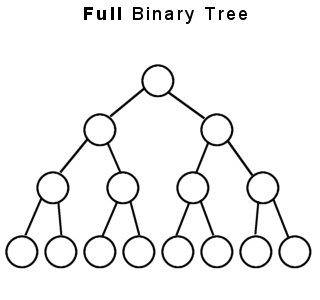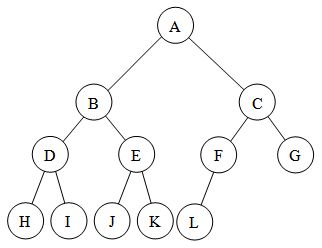There’s no place like a perfectly Self-balanced BST
“*Trees *Trees *Trees”
The title joke is shamelessly borrowed from the good old classic “There’s no place like 127.0.0.1”
What is Tree
Tree is a heavily used data structure in Computer Science. It’s easy to picture – just a root value and subtrees of children with a parent node, represented as a set of linked nodes(thanks wiki). They are non-linear data structure since data is not stired in a linear way, but hierarchically. It has following properties:
-
One node is marked as Root node.
-
Every node other than the root is associated with one parent node.
-
Each node can have an arbiatry number of child node.
Creating a tree in Python3:
class TreeNode:
def __init__(self, data):
self.value = data
self.left = None
self.right = None
Types
Binary Tree
A tree whose elements have at most 2 children is called a binary tree
 A Binary Tree example
A Binary Tree example
Full Binary Tree
A binary tree in which every node other than leaves has two children.
 Full Binary Tree
Full Binary Tree
Complete Binary Tree
A binary tree in which every level, except possibly the last, is completely filled, and all nodes are as far left as possible.

Binary Search Tree
Binary search trees (BST), sometimes called ordered or sorted binary trees, it has following properties:
-
The left subtree of a node contains only nodes with keys lesser than the node’s key.
- The right subtree of a node contains only nodes with keys greater than the node’s key.
- The left and right subtree each must also be a binary search tree.
There must be no duplicate nodes
| Average | Worst | |
|---|---|---|
| Space | O(n) | O(n) |
| Search / Insert / Delete | O(logn) | O(n) |
 Binary Search Tree
Binary Search Tree
Search a key in BST
First compare with root, then recur for the left or right tree.
def search(root, key):
if root is None or root.value == key:
return root
if root.val < key:
return search(root.right, key)
else:
return search(root.left, key)
Insert a node in BST
A new key is always inserted at leaf. We start searching a key from root till we hit a leaf node. Once a leaf node is found, the new node is added as a child of the leaf node.
11 11
/ \ Insert 40 / \
20 12 ---------> 20 12
/ \ / \
10 30 10 30
\
40
def insert(root, node):
if root is None or root.value == key:
root = node
if root.val < node.val:
if root.right is None:
root.right = node
else:
insert(root.right, node)
else:
if root.left is None:
root.left = node
else:
insert(root.left, node)
Delete a node in BST
-
delete leaf node: Simply remove from the tree.
-
delete node has only one child: Copy the child to the node and delete the child
-
delete node has two children: Find inorder successor of the node. Copy contents of the inorder successor to the node and delete the inorder successor. Note that inorder predecessor can also be used.
50 60
/ \ delete(50) / \
40 70 ---------> 40 70
/ \ \
60 80 80
The important thing to note is, inorder successor is needed only when right child is not empty. In this particular case, inorder successor can be obtained by finding the minimum value in right child of the node.
Inseresting facts:
- Inorder traversal of BST always produces sorted output.
- We can construct a BST with only Preorder or Postorder or Level Order traversal. Note that we can always get inorder traversal by sorting the only given traversal.
- Number of unique BSTs with n distinct keys is Catalan Number
BST Traversal
| Traversal Methods | Details |
|---|---|
| DFS Stack |
1. Pre order: root - left- right 2. In order: Left - root - right 3. Post order: Left - right -root |
| BFS Queue: need to track status |
Level Order Traversal: Left to right |
Self-balanced Binary Search Tree
Self-Balancing Binary Search Trees are height-balanced binary search trees that automatically keeps height as small as possible when insertion and deletion operations are performed on tree. The height is typically maintained in order of Log n so that all operations take O(Log n) time on average.
Why we need self-balanced BST?
In short, to improve operation performance.
There are some edge cases where inserting ordered data in BST results in a single list, which makes the lookup time O(n). So to avoid all this vases, we want the BST as balanced as possible – number of nodes on left and right tree do not differ too much.
Red Black Tree
 Red Black Tree
Red Black Tree
Red-Black Tree is a self-balancing Binary Search Tree (BST) where every node follows following rules.
-
Every node has a color either red or black.
-
Root of tree is always black.
-
There are no two adjacent red nodes (A red node cannot have a red parent or red child).
-
Every path from a node (including root) to any of its descendant NULL node has the same number of black nodes.
Every Red Black Tree with n nodes has height <= 2Log2(n+1)
Why Red-Black Trees?
Most of the BST operations (e.g., search, max, min, insert, delete.. etc) take O(h) time where h is the height of the BST. The cost of these operations may become O(n) for a skewed Binary tree. If we make sure that height of the tree remains O(Logn) after every insertion and deletion, then we can guarantee an upper bound of O(Logn) for all these operations. The height of a Red-Black tree is always O(Logn) where n is the number of nodes in the tree.
Red Black Tree V.S. AVL Tree
The AVL trees are more balanced compared to Red-Black Trees, but they may cause more rotations during insertion and deletion. So if your application involves many frequent insertions and deletions, then Red Black trees should be preferred. And if the insertions and deletions are less frequent and search more frequent, then AVL tree should be preferred over Red-Black Tree.
AVL Tree
 AVL Tree
AVL Tree
AVL tree is a self-balancing Binary Search Tree (BST) where the difference between heights of left and right subtrees cannot be more than one for all nodes.
Why AVL Tree?
Most of the BST operations (e.g., search, max, min, insert, delete.. etc) take O(h) time where h is the height of the BST. The cost of these operations may become O(n) for a skewed Binary tree. If we make sure that height of the tree remains O(Logn) after every insertion and deletion, then we can guarantee an upper bound of O(Logn) for all these operations. The height of an AVL tree is always O(Logn) where n is the number of nodes in the tree.
| METRIC | Red Black Tree | AVL Tree | |
|---|---|---|---|
| Insertion(Worst Case) | O(1) | O(logn) | |
| Max Tree Height | 2 * Log(n) | 1.44 * Log(n) | |
| Search(Worst) | O(logn) | O(logn) | |
| Deletion(Worst) | O(logn) | O(logn) | |
| Used when | always | when frequent lookup required | |
| Real world application | Multiset, Multimap, Map, Set, etc | DB Transactions |
Q TIME
Binary Tree Paths
def binaryTreePaths(self, root):
paths = []
path = ""
helper(root, path, paths)
return paths
def helper(self, node, path, paths):
if node is None:
return path
if node.left or node.right:
# result.append("->")
path = path + str(node.val) + "->"
else:
paths.append(path + str(node.val))
helper(node.left, path, paths)
helper(node.right, path, paths)
Validate BST
- Recursion: use in order traversal of BST.
def isBST(root):
out = []
inOrder(root, out)
for i in range(1, len(out)):
if out[i] <= out[i-1]:
return False
return True
for i in range(1, len(out)):
def inOrder(root, out):
if not root:
return
self.inOrder(root.left, out)
out.append(root.val)
self.inOrder(root.right, out)
Validate Full BST
- Iteration
def isFullBST(rot):
if not root:
return True
if root.left is None and root.right is None:
return True
if root.left is not None and root.right is not None:
return (isFullBST(root.left) and isFullBST(root.right))
# when none of above conditions work
return False
Validate Complete BST
DO Level Order Traversal from the root.
- We can define a term “Full node” whose both cildren nodes are not empty or not NULL. Then once one node found not be a “full node”, then every other node on the same level must be leaf nodes.
- If the left children node is empty, then right one MUST be empty.
def isCompleteBST(root):
if root is None:
return True
queue = []
flag = False # record not FULL node
queue.append(root)
while(len(queue) > 0):
tempNode = queue.pop(0) # Dequeue
if (tempNode.left):
if flag == True:
return False
queue.append(tempNode.left) # enque left child
else:
flag = True
if(tempNode.right):
if flag == True:
return False
queue.append(tempNode.right)
else:
flag = True
return True
BST Level Order Traversal
- Iteration(BFS)
Of course stack for iterative methods:
def levelOrder(root):
if not root:
return
res = []
queue = collections.deque()
# deque is preferred over list when
# quicker append and pop from botth ends need
# both O(1)
# implemented as a doubly linked list of block node
# so good for random-access and fixed length operations
queue.append(root)
while queue:
level = []
for i in range(len(queue)):
node = queue.popleft()
level.append(node.val)
if node.left:
queue.append(node.left)
if node.right:
queue.append(node.right)
res.append(level)
return res
- recursion(BFS)
Recursion method is still just defining another helper function.
def levelOrder(root):
res = []
dfs(root, 0, res)
return res
def dfs(root, depth, res):
if root == None:
return res
if len(res) < depth+1:
res.append([])
res[depth].append(root.val)
self.dfs(root.left, depth+1, res)
self.dfs(root.right, depth+1, res)
BST Pre Order Traversal
- recursion Easy to define a helper function to help with recursion.
def inOrder(root):
if not root:
return
out = []
helper(root, out)
return out
def helper(root, out): # helper func bcoz need to append result
if root:
out.append(root.val)
inOrder(root.left, out)
inOrder(root.right, out)
return out
- iteration
note signe.
def preOrder(root):
if not root:
return
stack = [root]
out = []
while(len(stack) > 0):
node = stack.pop()
if node.right is not None:
stack.append(node.right)
if node.left is not None:
stack.append(node.left)
BST In Order Traversal
- recursion Same as before, recursion’s syntax is much more concise.
def inOrder(root):
out = []
helper(root, out)
def helper(root, out):
if root:
helper(root.left, out)
out.append(root.val)
helper(root.right, out)
- iteration
def inOrder(root):
if not root:
return
out = []
stack = [root]
visited = set()
# need to track status, ortherwise will not be able to come back
while stack:
curr = stack.pop()
if curr not in the visited:
visited.add(curr)
if curr.right:
stack.append(curr.right)
if curr.left:
stack.append(curr.left)
else:
out.append(cuur.val)
return out
BST Post Order Traversal
- recursion
The easiest way is recursion method.
def postOrder(root): if not root: return [] # aaaaa - iteration ```python ans = []
def postOrderIterative(root): # edge case if root is None: return
stack = []
while(True): while (root): if root.right is not None: stack.append(root.right) stack.append(root)
root = root.left
root = stack.pop()
if (root.right is not None and
peek(stack) == root.right):
stack.pop()
stack.append(root)
root = root.right
else:
ans.append(root.data)
root = None
if (len(stack) <= 0):
break ``` ###### DFS Recursion Explained
Recursion is definitely an elegant way to solve questions but there’s one down side woth the memory usage.
Stack + recursion == messy memory performance
BST Zigzag Order Traversal
# Time Complexity: O(n)
# Space Complexity: O(n)+(n)=O(n)
def zigzagLevelOrder(self, root):
if not root: return []
result = []
queue = [(root, 0)]
while queue:
node, lvl = queue.pop(0)
if len(result) <= lvl:
result.append([node.val])
else:
if lvl % 2 == 0:
result[lvl].append(node.val)
else:
result[lvl].insert(0, node.val)
if node.left: queue.append((node.left, lvl+1))
if node.right: queue.append((node.right, lvl+1))
return result
Symmetric Tree
- recursion
def isSymmetric(self, root):
return isMirror(root, root)
def isMirror(root1, root2):
if not root1 and not root2:
return True
if not root1 or not root2:
return False
return (root1.val == root2.val) and isMirror(root1.left, root2.right) and isMirror(root1.right, root2.left)
- iteration
if not root:
return True
stackl, stackr = [root.left], [root.right]
while len(stackl) > 0 and len(stackr) > 0:
left = stackl.pop()
right = stackr.pop()
if not left and not right:
continue
elif not left or not right:
return False
if left.val != right.val:
return False
stackl.append(left.left)
stackl.append(left.right)
stackr.append(right.right)
stackr.append(right.left)
return len(stackl) == 0 and len(stackr) == 0
Same Tree
- Iteration
def isSameTree(p, q):
stack = [(p, q)]
while stack:
p, q = stack.pop()
if p == None and q == None:
continue
if p == None or q == None
return False
if p.val == q.val:
stack.append((p.right, q.right))
stack.append((p.left, q.left))
else:
return False
return True
- Recursion
def isSameTree(p, q):
if not p and not q:
return True
elif not p or not q:
return False
else:
return p.val == q.val and isSameTree(p.left, q.left) and isSameTree(p.right, q.right)
Maximum Depth of BST
- Iteration
def maxDepth(root): if not root: return 0 temp = [root] depth = 0 while temp: new_level = [] depth +=1 for node in temp: if node.left: new_level.append(node.left) if node.right: new_level.append(node.right) temp = new_level return depth - Recursion
def maxDepth(root): if root is None: return 0 else: left_height = self.maxDepth(root.left) right_height = self.maxDepth(root.right) return max(left_height, right_height) + 1BST Path Sum
How to find path sum from root to leaf that equals to given sum?
- iteration
def pathSum:
if not root:
return
out = []
stack = [(root, [root.val], root.val)]
while stack:
root, path, s = stack.pop()
if not root.right and not root.left:
if s==sum:
out.append(path)
if root.left:
stack.append((root.left,path+[root.left.val],s+root.left.val))
if root.right:
stack.append((root.right,path+[root.right.val],s+root.right.val))
return out
Reference
Huge thanks to Tutorials Point, G4G, Quora and Zhihu for the information.
Leave a comment